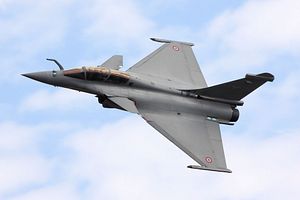As previously reported by The Diplomat, several Asian states are on a military shopping spree. Countries such as Indonesia, Malaysia and China are buying new fighters; Australia and Pakistan are getting new submarines. In contrast to the Cold War, when military purchases were primarily dictated by political affiliation with either Washington or Moscow (or, more rarely, London, Beijing, or Paris), the Asian arms market today involves dealers from all over the world.
French company Dassault is one of the players trying to expand its operations in the region. Known for its series of popular fighters, the Mirage, Dassault has previously delivered hardware to such diverse states as Israel, Argentina and Taiwan. These fighters proved popular, both due to their reliability and costs, as well as the fact that they represented an alternative to U.S. and Soviet models.
Dassault’s latest fighter, the Rafale, is a good platform. The fighter is a twin-engine, fourth generation multirole fighter, which means that it is supposed to be able to conduct a wide range of missions, including air-to-air combat, air-to-ground and air-to-sea strikes, and long-range reconnaissance. Furthermore, it is nuclear-capable, and constitutes a part of France’s “force de dissuasion”–its sea and air-based nuclear deterrence. In service since 2001, the Rafale serves as France’s main fighter, alongside the Eurofighter Typhoon and Dassault’s other modern fighter, the Mirage 2000. The Rafale has previously seen service in Libya, Mali, and Afghanistan and is currently involved in the French operation in Syria. The aircraft has been exported to Egypt and Qatar, which have each ordered 24 Rafales. (For technical specifications on the Rafale, see here and here.)
However, Rafale’s largest export market is India. Originally hailed as the “Mother of all Defense Deals,” India was set to purchase 126 Rafales back in 2012. However, as reported by Ankit Panda and Franz-Stefan Gady for The Diplomat, this deal has hit many roadblocks due to disagreements over price, offsets, and Indian specification demands their Rafales. The purchase has now been scaled down to 36 fighters in a government-to-government, of which the final details on offsets and technology transfers are still under negotiation.
Despite the Indian disappointment, Dassault has other potential customers in the Asia-Pacific. Malaysia is set to replace its ageing MiG-29s, and has requested proposals from companies around the world. In addition to the Rafale, the Eurofighter Typhoon, Saab’s Gripen C/D, and Boeing’s F/A-18E Super Hornet are being considered. While there is speculation that the Swedish Gripen will win due to its competitive price, Dassault is still confident the Rafale has a good chance of winning the competition.
According to Reuters, Dassault is hoping to provide Kuala Lumpur with 18 Rafales. A spokesman from the French company stated that “We have the feeling that there is a clear preference for the Rafale because they have not made the same type of announcement for the other manufacturers being considered,” the source said. “We are entering concrete discussions.”
While not an Asian state, Canada has announced that it will abandon its participation in the F-35 Joint Strike Fighter program after the Liberal Party’s victory in Canadian national elections last month. Dassault is apparently offering the Rafale as an alternative to the F-35, and has several advantages over some of its competitors, the Typhoon, Gripen, and Super Hornet. Whatever the outcome, Ottawa’s withdrawal from the project could have some serious implications for other participants in the F-35 program, such as Australia, where the JSF is already a controversial issue.
The Rafale shows that Dassault is still a global player on the international arms stage. The fighter has so far given good service for France, and its exports to Egypt and Qatar shows that it is competitive with some of the best fighters in the world. However, the company has also lost many of its bids. In the Asia-Pacific, the Rafale was unable to win contracts with Singapore and South Korea, and only has a small bid in Malaysia.
Dassault’s golden days during the Cold War are over. That does not mean that the company in any way produces underperforming aircraft, but it looks like it has to step up its game in order to compete in an increasingly crowded field.

































